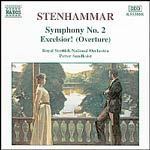
Stenhammer-Symphony No. 2 / Excelsior!
 $25.00
Out of Stock
$25.00
Out of Stock6+ weeks add to cart
Stenhammer-Symphony No. 2 / Excelsior!
Royal Scottish National Orchestra Petter Sundkvist, conductor
[ Naxos / CD ]
Release Date: Saturday 30 November 2002
This item is currently out of stock. It may take 6 or more weeks to obtain from when you place your order as this is a specialist product.
"persuasive and vibrant readings...plenty of fire and passion"
"Petter Sundkvist gives persuasive and vibrant readings...the RSNO has plenty of fire and passion"
- BBC Music Magazine
"the quality of the performance is such as to deserve a strong recommendation"
- Gramophone
"the Royal Scottish National Orchestra under the young Swedish maestro Petter Sundkivst does full justice"
- Fanfare
During the 19th Century, Swedish audiences were as cool in their reception of symphonic music by native composers as the British audiences had grown in respect of their own native symphonists. The lack of popularity of the music of Franz Berwald was just one instance of this absurdity.
That was all to change - as in Britain - at the beginning of the 20th Century and a new generation of Swedish composers emerged, devoting themselves to large scale works.
Among them, was Wilhelm Stenhammar. At first, he was a Bruckner advocate, describing his first symphony as "idyllic Bruckner". But that was totally shattered a month or so before the first performance, when he encountered Sibelius's second symphony. It was almost enough for him to withdraw his first symphony, and it was almost ten years after that experience that Stenhammar felt able to return to symphonic form. He therefore wrote on his new score "Symphony Op.34 for Orchestra", almost as if that first symphony had never existed. Indeed he was never to describe the G Major symphony as anything other than his first and only symphony. It is only subsequently that the world has decided to describe it as No.2.
It took no less than four years to complete, having started out life on a holiday in Rome in the spring of 1911, and being first performed in Gothenburg in April 1915.
Stenhammar was also a noted conductor, and during this period, he rehearsed a number of works by Sibelius, and conducted music by Strauss, Reger, and Debussy. But it was a distillation of that music together with the experience of performing Nielsen's First Symphony that was to colour this work. It is in four movements in which Stenhammar looked back to the musical form in what he described as "ancient days". There is reference to folk song and folk dance in all the fast movements, the slow movement having the nature of a funeral march or hymn.
The finale is by far the longest movement, based on a series of fugues, culminating in an (N)impassioned song like passage, and one of the most original sections composed by a Swedish composer up to that time.
Prior to the first symphony, Stenhammar had flexed his symphonic muscle with a dramatic overture, Excelsior, composed at the age of 24. It does display a degree of immaturity, but has an heroic element, which was to feature in much of the Scandinavian music of that period.
This disc, made in Glasgow, in August of 1996, is conducted by one of the most exciting younger generation of Swedish musicians, Petter Sundkvist, and features the fine orchestra, the Royal Scottish National, in a series of British and Scandinavian music recordings, which the orchestra has undertaken for the Naxos label.
The producer is Paul Meyers, whose disc of music by Bliss was recently nominated by the Gramophone magazine, as the "Record of the Month".
Tracks:
Symphony No.2 Op.34
01. Allegro energico 12:03
02. Andante 09:27
03. Scherzo 07:08
04. Finale 15:56
Excelsior! Op.13
05. Excelsior!, Symphonic Overture, Op. 13 13:05

